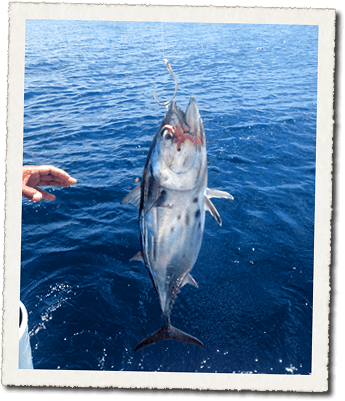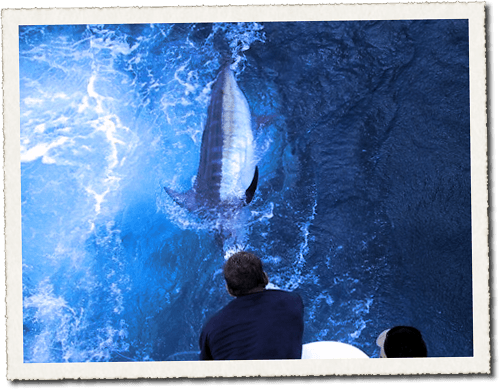Live Baiting For Game Fish
Live Baiting is the use of a live fish as bait, it has the advantage of having a truly natural appeal – a live tuna, (yellowfin, skipjack, bonito), blue runner, goggle eye or sardine etc. - that a marlin, or other large predatory game fish would naturally eat as a food source.

It’s disadvantage is that you cannot cover ground at the speed which you may troll lures. it is a slower approach usually from 0-4 knots, to avoid dragging the baitfish, and having it tire too soon. This limits the amount of area that can be covered in a given amount of time while looking for fish.
Live baiting works best when you are in an area that is known to have predatory game fish, such as marlin or large tunas, or has several indicators in a small area that would be consistent for conditions that may attract, or be signs of marlin (i.e. temperature, water color, bait, structure, a big marlin chasing bait on the surface).
Often while offshore fishing here in Costa Rica, we find many of these conditions in place; the two key indicators to influence a switch from trolling to live baiting would be the presence of bait and structure.
Structure may be large and geographic, such as rocks, reef, ledges, drop-offs, holes (craters), pinnacles or points (corners) even and island or any feature that may affect currents, attract baitfish and predators.

Structure may also be more temporary and mobile in nature and on a smaller scale. It may be floating logs, trees, debris, or even a dead turtle or whale. The key is something that offers a change, or shelter from the vast openness of the ocean. Often something floating, even something a small as a branch, bucket or plastic cup, can be the base of a micro ecosystem of life in the open ocean.
Small minnows and baby game fish begin to gather in the shadow for protection. Barnacles and crabs begin to latch onto the object as home. This is the start of a food chain. This begins to attract more and more types of life and eventually predators begin to show up and patrol the perimeter looking for an opportunity to feed. Small jacks, rainbow runners, Dorado, Wahoos, and Tunas may use this as their temporary home and shelter, and soon after the apex predators, marlin and sharks will be drawn in to the oasis.
This is an ideal senario to find while offshore fishing. Plentiful supply of bait around floating debris. Even if the marlin isn’t there, it offers lots of action for light tackle fishing and a chance to take home dinner. We often carry live blue runners aboard every trip, but it is always nice to have the opportunity to catch a fresh tuna, skippy or bontita from under a log, and bridle it up on a circle hook and put it right back out. This is true marlin candy.
We usually will pull spoons, cast jigs or use sabikikis to catch the bait. The bait must be handled quicky and with care to maximize its survival and liveliness. Small tuna type baits, can be extremely delicate. They cannot be out of the water for long, or banged around.
In order to breath, tunas must constantly be moving forward, and we have specialized tuna tubes, in order to keep a few live ones ready.
Once caught and boatside, the mate will quickly lift the tuna and hold him upside down in a towel to reduce stress on the fish and keep him calm and manageable. Then the bait is “bridled” with a floss or Dacron loop, being feed though its eyes socket above the eyeballs, which is used for the secure connection to the circle hook. Placing the hookoutside the baitfish’s head, giving the hook maximum exposure, allowing it more fexiblity to work the way it should, providing higher hook up ratios.
The bait is then placed in the water and slow trolled around the prospective area awaiting a hungry gamefish to encounter it.


